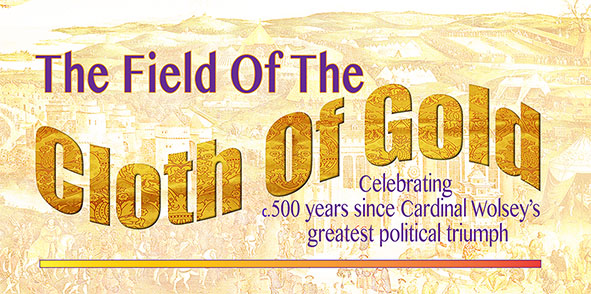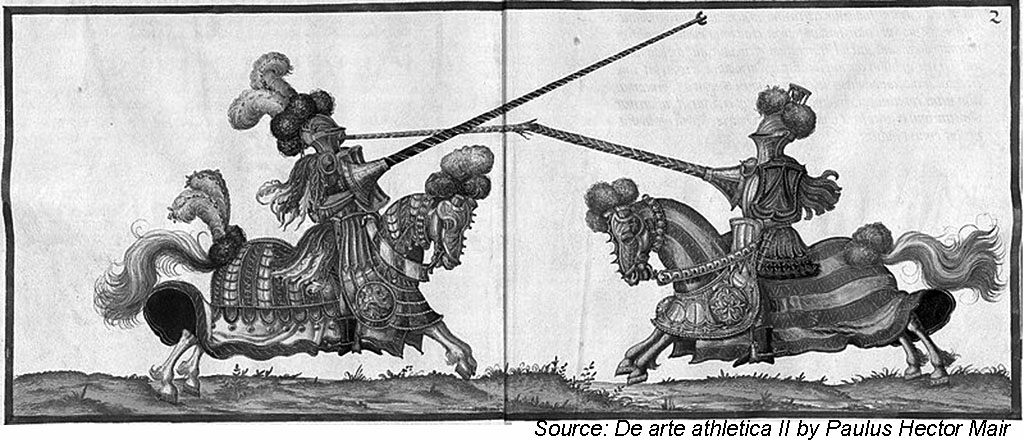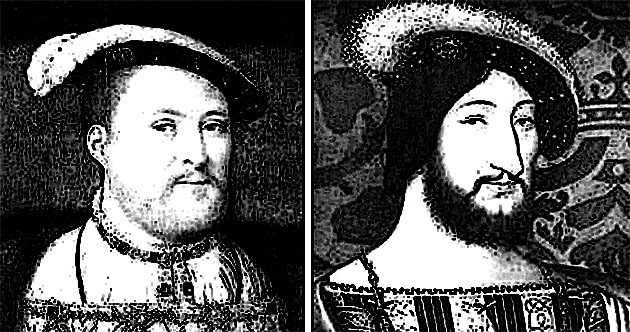- Screen Colours:
- Normal
- Black & Yellow

‘Those who cannot remember the past are condemned to repeat it.’ George Santayana
In this year when we are celebrating ‘Wolsey 550’ – the number of years since the birth of the most famous son of Ipswich – the Cardinal’s most successful diplomatic tour de force is often forgotten. Perhaps the massive junket that became known as The Field of the Cloth of Gold is now considered so overblown, so vain, so wasteful that it really doesn’t bear thinking about.
In the spring of 1520, 6,000 English men, women and servants followed their king across the sea to France. This wasn’t an invasion force, they were attendants to King Henry VIII to take part in the most conspicuous display of wealth, culture and courtly sports that Europe had ever seen. They were met by Francis I, King of France, and a similar number of French noblemen, women and servants on English soil in northern France. The English erected a temporary palace. There elaborate tents, jousting arenas and pavilions and golden fountains spouting perpetual red, white and claret wines. For just over two weeks they created a temporary town the size of Norwich, then England’s most populous city, on the ‘Camp du Trap D’or’ – The Field of the Cloth of Gold.
The geopolitical backdrop of the time was complex. There were three main powers, of which England was the smallest, its population only about two-and-a-half million. France was much larger at 16 million people and the third power was that being put together by Charles of Hapsburg which included the Netherlands, Spanish kingdoms, Austria, southern and western Germany – the biggest empire in Europe – and unpredictable. The Ottoman empire in the east was expanding, too.
The 1518 Treaty of London had been intended bring together all the European powers in a non-aggression pact and, ultimately, to resist the Ottoman threat. As the smallest international player, it is an indicator of the ambition of Henry VIII and his trusted lieutenant Cardinal Wolsey that they seized the initiative and had the treaty signed in London.
Wolsey was a genuinely international figure, serving his mercurial master. Always assiduous in this, he applied his great intelligence, cunning and an immense capacity to micro-manage affairs to achieve what others might have assumed were impossible goals. He is a Renaissance Cardinal and a Special Legate to the Pope, giving him tremendous powers. He could be described as ‘The Pope of northern Europe’. In exercising his tremendous power to achieve The Field of the Cloth of Gold, the Pope was very unhappy that he wasn’t kept informed by Wolsey. In the preparation of this huge festival he was representing both his own king and Francis I.

Thomas Wolsey, a prodigy reputed to be a butcher’s son from Ipswich, is at this time a charismatic, immensely wealthy (not to mention vain) and equally powerful workaholic. He was a master of diplomacy, also of rhetoric and persuasion, not to mention being his own Public Relations consultant. Henry was beguiled by him and, in this period, the king was content to licence Wolsey to run most of domestic policy and much foreign policy on his behalf. By 1518 Wolsey was riding high on a policy of peace. Thomas Moore entered the king’s service at this time and he did so because he believed that Wolsey was the man to change both England and the world in a Renaissance humanist vision of peaceful co-existence. Wolsey, seldom suffering from modesty, sees himself as arbitrator in excelsis.
Such was the stage upon which the great festival would be set. Wolsey was very much the architect of the massive event and had the ear of the French king to broker the agreement between the two monarchs, both in their twenties, to meet in this way. The aim was to bring the two old enemies together in peace. The personal aspect of their mutual curiosity to meet the other also drove the project. They both made much of their physical strength and athleticism in military pursuits and hunting – not to mention an interest in the women of their respective courts.
The English had held the Pale of Calais since 1347 and Calais was the main English military and trade base in France. The siting of the festival was determined by this, but also the requirement to get the French to agree to enter English territory. A site as near as possible to the border was therefore chosen.
The 6,000 English entourage had to be accommodated. A replica of a large royal palace in Classical style was constructed, masterminded by Wolsey. A brick base held timber and canvass structures, painted by craftsmen to look like solid walls and roofs. In the courtyard, visitors were struck by 5,000 feet of clear glass in bay windows and apartments laid out on a quadrant for the royal party. Beyond that there was a chapel, then a gallery which led to Guînes Castle where the many of the English were staying. There were also about 200 smaller tents. Wolsey sought peace through magnificence.
The French, by comparison were trumped by these stunning English structures, because they relied on tents, albeit elaborate. As well as the royal tents, there were 400 more for accommodation.
A programme of jousting and feats of arms was designed to symbolically represent the traditional vision of kings as great warriors, all carefully planned by Wolsey to create absolute balance between the two sides. The terrain of the field was sculpted so that when the two kings saw each other for the first time, they would be at exactly the same physical level. The one-to-one meeting on 7 June, 1520 was marked by a fanfare and the two monarchs on horseback left their entourages to meet at the appointed place and embrace. Everything was choreographed by ‘The Son of Ipswich’.
Inevitably, splendour ran into gluttony during the great gathering. Keeping the fountains running with wine probably took most of the 40,000 gallons they brought with them. They also had 14,500 gallons of beer and ale along with the means of brewing more, were it required. The fish supplies alone included 9,100 plaice, 7,836 whiting, 5,554 sole, 2,800 crayfish, 700 conger eels, 3 porpoises and a dolphin. 337 oxen and 2,000 sheep made up part of the meat menu, so there were busy butchers on site along with chefs, assistants and serving staff. There was little to stop hangers-on from outside free-loading on the plentiful food and alcohol.
The VIPs were dressed in the most spectacular fashion they could including fine silks, velvets, cloth-of-gold and of silver and so on. Many palaces, stately homes and churches were emptied of their plate, jewels and finery such as tapestries and Turkish carpets to furnish the replica palace. Extravagance and glamour was also embodied by the richly attired women, particularly on the French side, where the Italian ambassador was very critical of the provocative Italian Renaissance-style dresses being worn.
Meanwhile, Wolsey and his French counterpart engineered not only the main diplomatic engagement of the kings, but many ambassadorial meetings and discussions to encourage closeness and co-operation. On Sunday there was no fighting or jousting, so the kings went off to dine with each other’s queens; Wolsey dined with the Queen Mother of France, Louise of Savoy. At other times, the English archers put on a fine display – perhaps to remind the French of their defeat at Agincourt – and wrestling bouts took place.
The whole event culminated in a great Mass of Corpus Christi, officiated over and sung by Wolsey, of course, with English Knights and nobles holding the bowls and towels for when he washes. This must have pleased the Cardinal greatly. The Mass was interrupted by the flight above the crowd of a fiery dragon or similar. It has been suggested that this was a large painted kite (perhaps with associated fireworks) being drawn by horses and cart.
The festivities ended with each king giving the other expensive gifts of jewels as an expression of their friendship. The Field of the Cloth of Gold event had cost each king staggering amounts – Henry VIII had spent around £36,000 (more than one-third of England’s total annual income of £90,000) while Francis had spent around £40,000. Was it all just a magnificent folly? Three years later England and France were at war again.
RG

Henry VIII, King of England; Francis I, King of France